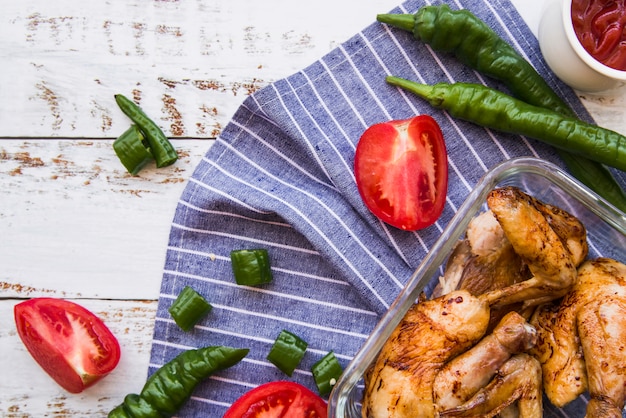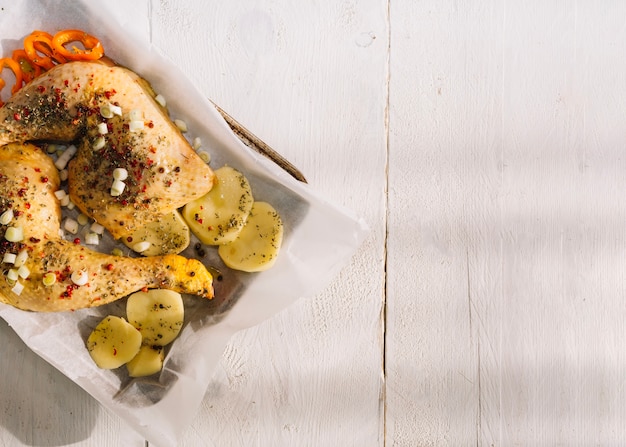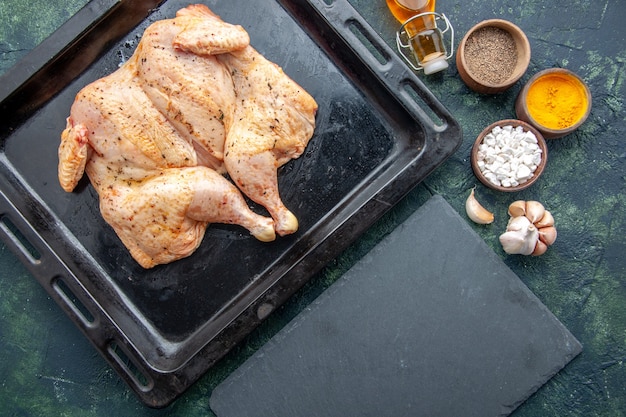As a seasoned cook (and avid chicken thigh enthusiast), I've learned a thing or two about getting that perfect bite. You know, the kind that's juicy, tender, and bursting with flavor? It's all about nailing the internal temperature, my friends. And that's what I'm going to share with you today.
Think of it this way: a thermometer is your best friend in the kitchen. It's the key to unlocking the secrets of perfectly cooked poultry. It's not just about avoiding that dreaded salmonella, though that's definitely a good thing. It's about ensuring a delicious and safe meal. So, let's get down to the nitty-gritty, shall we?
(Part 1) The Science of chicken thighs

First, a little bit of science to set the stage. Chicken thighs are a bit different than breasts, which can be a bit more tricky to cook. They have a higher fat content, which makes them more forgiving when it comes to overcooking. The fat helps keep them moist, giving you a more succulent and flavorful result.
This higher fat content means chicken thighs tend to cook more evenly. This makes them less prone to drying out. Unlike chicken breasts, which can easily become tough and rubbery if overcooked, chicken thighs can withstand a little extra time in the heat. This makes them a great choice for beginners or those who are a bit less experienced in the kitchen.
Why Temperature Matters
Now, the internal temperature is crucial because it tells you when the chicken has reached a safe and delicious point. The USDA (that's the United States Department of Agriculture, for those who aren't in the know) recommends a minimum internal temperature of 165°F (74°C) for cooked chicken. But here's the thing: just because it's safe doesn't mean it's delicious!
The Sweet Spot: The "Safe" Zone
You see, that 165°F (74°C) is the point where the chicken is fully cooked, but it might end up a little dry and tough. For the most flavorful and tender chicken thighs, you want to aim for a slightly lower temperature, somewhere around 160°F (71°C). That's the sweet spot where the chicken is still juicy and tender, but perfectly cooked.
Think of it like baking a cake: you want the cake to be cooked through, but you don't want it to be dry and crumbly. The same goes for chicken. By aiming for a slightly lower internal temperature, you can ensure that your chicken thighs are cooked through, but still retain their natural moisture and tenderness.
(Part 2) Cooked to Perfection: Different Methods, Different Temperatures

Okay, so we've got the science down. Now, let's dive into the different cooking methods and how the temperature changes. Remember, this is where your thermometer comes in handy!
Baking
baking chicken thighs is a classic method for a reason. It's simple, reliable, and results in tender, juicy meat. You can bake them whole, bone-in, or boneless, skin-on or off. The key is to ensure the internal temperature reaches 160°F (71°C) at the thickest part of the thigh.
Baking is a great way to cook chicken thighs because it allows for even heat distribution. The oven cooks the chicken slowly and gently, allowing the fat to render and the meat to become tender. You can also bake chicken thighs with a variety of herbs and spices, which will add flavor to the dish.
Pan-Frying
For a crispy skin and juicy interior, pan-frying is the way to go. It's a bit quicker than baking, but the technique is important. You want to sear the thighs over medium-high heat to develop that golden-brown crust. Then, reduce the heat and cook until the internal temperature hits 160°F (71°C).
Pan-frying is a great way to add flavor and texture to chicken thighs. The high heat will sear the chicken, creating a crispy skin. Once the chicken is seared, you can reduce the heat and allow it to cook slowly, allowing the fat to render and the chicken to become tender. You can pan-fry chicken thighs with a variety of ingredients, such as garlic, onions, and herbs.
Grilling
Grilling brings out that beautiful smoky flavor in chicken thighs. It's a perfect summer cooking method. Just make sure to keep an eye on the temperature, as it can fluctuate depending on the heat of your grill. Aim for 160°F (71°C) at the thickest part of the thigh.
Grilling is a great way to cook chicken thighs quickly and easily. The high heat of the grill will sear the chicken, creating a crispy skin. The smoky flavor of the grill will add another dimension of flavor to the chicken. You can grill chicken thighs with a variety of marinades and sauces.
(Part 3) Don't Just Go By Looks

Now, here's a little nugget of wisdom. Don't just go by the looks of the chicken! Chicken can brown and appear cooked on the outside, but still be undercooked on the inside. That's why a thermometer is your absolute best friend.
Visual Clues
You can look for certain clues, though: The juices should run clear, not pink. The skin should be golden brown and crispy. But these are just indicators. The only way to be sure is with a trusty thermometer.
These visual cues can be helpful, but they are not foolproof. The only way to be certain that your chicken is cooked through is to use a thermometer.
(Part 4) Using a Thermometer: A Step-by-Step Guide
Right, let's talk thermometers! They're easy to use, but there are a few things to keep in mind:
Types of Thermometers
- Instant-Read Thermometers: These are the most common and convenient. They give you a quick and accurate reading.
- Probe Thermometers: These are great for leaving in the chicken while it cooks. They continuously monitor the temperature and alert you when it's ready.
Both instant-read and probe thermometers are useful tools for cooking chicken. Instant-read thermometers are great for getting a quick reading of the internal temperature of the chicken. Probe thermometers are useful for monitoring the temperature of the chicken over time.
Using a Thermometer:
- Insert the thermometer: Insert the thermometer into the thickest part of the thigh, making sure it doesn't touch bone.
- Wait for a steady reading: Don't just peek at it after a few seconds. Hold it there until the temperature stabilizes.
- Check the temperature: The thermometer should read 160°F (71°C) for perfectly cooked chicken thighs.
It's important to insert the thermometer into the thickest part of the thigh, as this is where the chicken will be the slowest to cook. Wait for the temperature to stabilize before taking a reading. This will ensure that you get an accurate reading.
(Part 5) Time and Temperature: A Balancing Act
Remember, the cooking time can vary depending on the size and thickness of the chicken thighs, the method you're using, and the temperature of your oven or grill. That's why the thermometer is so important.
Approximate Cooking Times
Here are some general guidelines for cooking times, but always double-check with a thermometer!
| Cooking Method | Approximate Cooking Time |
|---|---|
| Baking (350°F/175°C) | 30-40 minutes |
| Pan-Frying | 10-15 minutes per side |
| Grilling | 10-15 minutes per side |
These cooking times are just estimates. It's always best to use a thermometer to ensure that the chicken is cooked through.
(Part 6) Chicken Thighs: Versatile and Delicious
Once your chicken thighs are perfectly cooked, the possibilities are endless! They're so versatile, you can use them in any number of dishes.
quick and easy meals
- Chicken Stir-Fry: Add your cooked chicken thighs to a stir-fry with your favorite vegetables and sauce. It's a quick and easy weeknight meal.
- chicken salad Sandwiches: Shred your cooked chicken thighs and mix them with mayonnaise, celery, and onions for a classic chicken salad sandwich.
Showstopping Dishes
- Roasted Chicken Thighs with Herbs: Roast your chicken thighs with rosemary, thyme, and garlic for a delicious and aromatic dish.
- Chicken Thighs with Lemon and Butter: Pan-fry your chicken thighs with lemon and butter for a simple but elegant meal.
These are just a few ideas for using perfectly cooked chicken thighs. With a little creativity, you can come up with endless possibilities.
(Part 7) Don't Overcook!
I've been there. We've all been there. That feeling of dread when you realize you've overcooked the chicken, leaving it dry and tough. Don't fret! There are ways to salvage it.
Salvaging Overcooked Chicken
- Add moisture: Add a little bit of broth or sauce to help rehydrate the chicken.
- Shred and use in a dish: Shred the overcooked chicken and use it in a soup, casserole, or salad.
But the best way to avoid overcooked chicken is to use a thermometer!
It's much easier to prevent overcooked chicken than it is to salvage it. By using a thermometer, you can ensure that your chicken is cooked through but not overcooked.
(Part 8) FAQs: Your Chicken Thigh Questions Answered
I know you have questions. That's what makes learning fun, right?
FAQs:
- Q: Can I cook chicken thighs to a lower temperature?
A: Technically, you can cook chicken to a lower temperature if you're comfortable with it. However, the USDA recommends 165°F (74°C) for safety reasons. It's ultimately up to you, but I recommend sticking to 160°F (71°C) for the best flavor and texture. Cooking to a lower temperature can be a bit riskier, but it can result in more tender and flavorful chicken. Just be sure to use a thermometer to ensure the chicken is cooked through.
- Q: Should I remove the skin from chicken thighs before cooking?
A: It's up to you! The skin adds flavor and moisture, but you can remove it if you prefer. If you're watching your fat intake, removing the skin is a good option. If you leave the skin on, it will help to keep the chicken moist and tender. You can also crisp up the skin for a delicious addition to your dish.
- Q: How do I know if my thermometer is accurate?
A: You can test your thermometer by placing it in a cup of boiling water. It should read 212°F (100°C). If it doesn't, you might want to get a new one. It's important to ensure that your thermometer is accurate, as this will help to guarantee that your chicken is cooked to the correct temperature.
- Q: What happens if I undercook chicken?
A: undercooked chicken can be dangerous. It can contain bacteria that can make you sick. Always make sure your chicken is cooked to a safe internal temperature. Undercooked chicken can cause foodborne illness. It's important to cook chicken to the correct temperature to kill any harmful bacteria.
- Q: What are some good tips for keeping chicken moist while cooking?
A: Here are a few tips for keeping your chicken thighs juicy and tender:
- Don't overcrowd the pan. Overcrowding the pan will prevent the chicken from cooking evenly and will cause it to steam rather than sear.
- Don't overcook the chicken. Overcooking chicken will dry it out. Use a thermometer to ensure that the chicken is cooked to the correct temperature.
- Use a marinade or brine to help retain moisture. Marinades and brines help to keep chicken moist by adding flavor and moisture.
So, there you have it! The secrets to perfectly cooked chicken thighs are right at your fingertips. Remember, a thermometer is your best friend in the kitchen. And with a little practice, you'll be whipping up delicious, juicy chicken thighs in no time. Happy cooking!
Everyone is watching

Prime Rib Roast Cooking Time Chart: Per Pound Guide
Cooking TipsPrime rib roast. Just the name conjures images of lavish dinners, crackling fires, and hearty laughter. It’s ...

How Long to Bake Potatoes in the Oven (Perfect Every Time)
Cooking TipsBaked potatoes are a staple in my kitchen. They're incredibly versatile, delicious, and surprisingly easy to m...

Perfect Rice Every Time: The Ultimate Guide to Cooking Rice
Cooking TipsAs a self-proclaimed foodie, I've always been a bit obsessed with rice. It's the foundation of countless cuisi...

The Ultimate Guide to Cooking Asparagus: Tips, Techniques, and Recipes
Cooking TipsAsparagus. The mere mention of this spring delicacy conjures up images of vibrant green spears, crisp and burs...

Ultimate Guide to Cooking the Perfect Thanksgiving Turkey
Cooking TipsThanksgiving. Just the word conjures up images of overflowing tables laden with delicious food, the scent of r...
